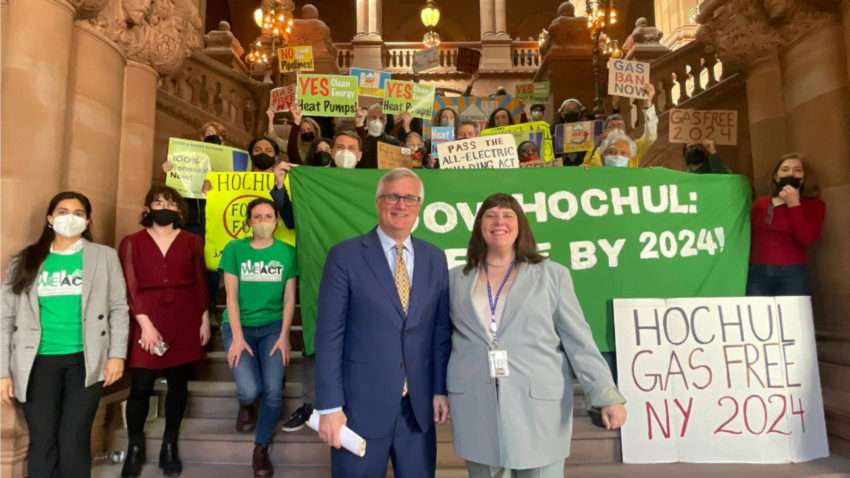New York is going electric. In a major move toward cutting fossil fuels, New York is now the first state to require newly constructed buildings to be made fully electric after the State Fire Prevention and Building Code Council’s meeting last Friday. Starting in 2026, new buildings that are seven stories or less, whether residential or commercial, must be built with all electric rather than fossil fuel equipment to curb New York’s top source of carbon emissions — buildings. By 2029, all newly constructed buildings — besides stated exceptions such as hospitals or restaurants — in New York will be mandated to use electric heat and appliances in a challenge against federal rollbacks on climate action programs.
The state law behind the all-electric building code, known as the All Electric Buildings Act, was actually passed two years ago after organizing by climate advocates, who found themselves up against the combined forces of fossil fuel companies, gas utilities and real estate. “A real battle to get passed,” said assemblymember Emily Gallagher, who was the bill’s main sponsor, at a virtual press conference last Friday, it was only just implemented into New York’s building code after repeated issues of the all-electric provision not being included in preliminary drafts of the 2025 code despite it being legally required. But the state’s move towards electricity was further bolstered by a legal victory back in March, in which a district court judge dismissed a challenge to a similar electrification law in New York City brought upon by plumbing and building trade groups.
Alongside Gallagher, other policymakers, climate activists and local contractors in support of the act came together to speak at a virtual press conference immediately following the Council meeting on Friday. One of the featured speakers of the press conference, Michael Hernandez, has been active in the nationwide fight for electrification as New York Policy Director for the nonprofit Rewiring America. In an interview with Radio Catskill, Hernandez said that electric appliances, which are characterized by their energy efficiency, lack of emissions and ability to be powered by renewable energy sources, are key in a state where buildings currently comprise 33% of statewide greenhouse gas emissions and around 70% of just New York City’s.“ When you’re using fossil fuels to cook or heat your home, you’re looking at technology that was developed like a hundred years ago,” he said. “The induction stoves, the heat pumps — these are state-of-the-art technologies that literally move heat in the air from outside to inside or from the ground to inside and do so in a very efficient way.”
Furthermore, Hernandez and other advocates argue that electrification stands to benefit New Yorkers directly. How? Lower costs, reduced health risks and increased resiliency. In addition to creating 100,000 jobs, the All-Electric Buildings Act is set to save New Yorkers living in newly constructed all-electric buildings about $1,000 a year in energy bills, Hernandez said, which aligns with the state’s other major goal of increasing affordable housing.
[The savings] happen in a number of ways,” Hernandez said. “The appliances themselves are far more efficient, and they use a lot less energy in their operation than conventional appliances. Also, they have a lot more nuance and technology built into them […] For instance, if you have an EV vehicle, you might say, ‘oh, I’m gonna charge at nighttime when there’s not peak demand on the grid.’ And if I have a time of use rate, then I can actually charge my car battery up at a time when my energy costs are very low […] and you can do that with any kind of appliance.”
For Lonnie J. Portis, who represented the community-based organization WE ACT for Environmental Justice as its Director of Policy and Legislative Affairs at the press conference, the act has a critical health dimension as well. Portis described how fossil fuel emissions from buildings have contributed to nearly 2,000 premature deaths across the state, with studies showing that low-income communities and communities of color are facing the brunt of these health issues.
Rise Boro CEO Kieran Harrington spoke specifically to Bushwick, which currently suffers the highest concentration of asthma hospitalizations for children in the city due to fossil fuel emissions from homes. While his community partnership is actively trying to combat this issue by building affordable, all-electric homes in the predominantly Hispanic neighborhood for existing and new residents, health risks persist in a largely fossil fuel landscape.
“I think what we’ve seen research has shown is that within environmental justice communities, there is a disproportionate health impact, and it’s in the aggregate,” Hernandez said. “Because if you have a lot of polluting sources within your community, and then you also on top of that have polluting appliances within your apartment, and then you have a lot of people all in a smaller space, all of those things are a compounding impact of health disparity that creates asthma and emphysema and a lot of other health issues related to burning fossil fuels in your house, in your home.”
The push for electrification has not been without its pushback, including from construction companies and contractors that have cited higher construction costs with all-electric buildings. Harrington, however, stated that there has been no additional costs for Rise Boro in constructing their all-electric homes in Bushwick — with the only cost differences coming from energy savings over time for both landowners and tenants. Furthermore, Jay Best, CEO of Green Team Long Island, said to the press that “the contractors are ready.” The contracting company has been offering electric appliances, such as energy-efficient heat pumps, that Best said have come to outsell traditional furnaces and have become “something that we’re comfortable doing.”
Amid additional concerns over the reliability of all-electric buildings in cases where the electrical grid cannot be accessed, such as during a power outage, Hernandez explained that electric appliances are just as reliable, if not more, than their traditional gas counterparts.
“You just have a lot more resiliency with electrified appliances as well,” Hernandez said. “You can have battery backup within the appliance itself. You can have energy storage systems, and then you can also have your own sources of renewable energy generation, whether that’s a solar power on your roof that’s feeding into your energy storage system in your garage. And then that’s powering all of your appliances, and you’re not even spending money on utilities trying to bring over energy to your home.”
And electrification doesn’t stop there. Alongside the All Electric Building Act, the 100-foot gas rule was also repealed in the state’s 2025 legislative session, which had cost New Yorkers $200 million annually to subsidize utility companies for the cost of extending gas lines to properties located within 100 feet of an existing line. In addition, a Cap-and-Invest program was proposed to help 46% of households in New York upgrade to an energy-efficient heat pump by 2035, which is set to save the median household between $803.41 and $1,022.60 annually in terms of energy costs.
However, this comes as the energy landscape in New York becomes increasingly shaky. Renewable energy generation will become more costly to implement after Trump eliminated the clean energy tax credits that came out of the Biden administration’s 2022 Inflation Reduction Act. These popular tax breaks had made it cheaper for both individual Americans and renewable energy companies to build and install renewable energy infrastructure, and now solar and wind companies are left with only a year with these federal credits to carry out their projects, according to New York Focus. As the push towards electrification is set to increase electricity demand, Governor Kathy Hochul is simultaneously planning to build a new nuclear power station — New York’s first in almost four decades — after the Indian Point nuclear plant closed in 2021 alongside fossil fuel plants that the state had relied on.
But as all-electric buildings begin to be constructed in New York, with the state building approximately 40,000 new buildings a year, Hernandez said he hopes it will begin to shift the state away from fossil fuels as New Yorkers see higher efficiency and reduced costs in action.
“We have between seven and 8 million buildings in New York State, so when you think about new buildings of only about 40,000 a year, the impact is not as big as the existing buildings really are,” Hernandez said, “But what I think will happen is that homeowners of existing buildings will look and say, ‘why do I have this old, outdated system in my home? It’s more expensive, it’s dirty, it’s contributing to climate change. There’s just better technology out there now, and they’re only building new buildings with the better technology.’ And I think that’s gonna really, in addition to a lot of the incentives that New York and the federal government are providing, [motivate] people to move away from their fossil fuel combustion systems.”
Image: Senator Brian Kavanagh, the main Senate sponsor of the All Electric Buildings Act, and assemblymember Emily Gallagher, its prime sponsor, stand at a rally with climate advocates for the bill on March 22, 2022 (Photo credit: assembly.state.ny.us)


Screw NY. We stand to freeze to death in winter and cook the rest of the time.
While I definitely favor backing off from fossil fuels, including natural gas and its derivatives, as much and as fast as possible, this initiative is not well thought out.
Even beyond the superiority of gas or propane cooking to electric stoves or cooktops, the frequency of winter power outages and the fact that fossil fuels drive most electricity production are very real concerns. I can’t count on even two hands the number of times my little propane stove has saved me in winter after Catskill winter.
Until and unless the grid can be guaranteed not to go down [e.g., with underground lines] and the production of power no longer depends on fossil-fueled or nuclear plants, a law like this looks mostly like window dressing.